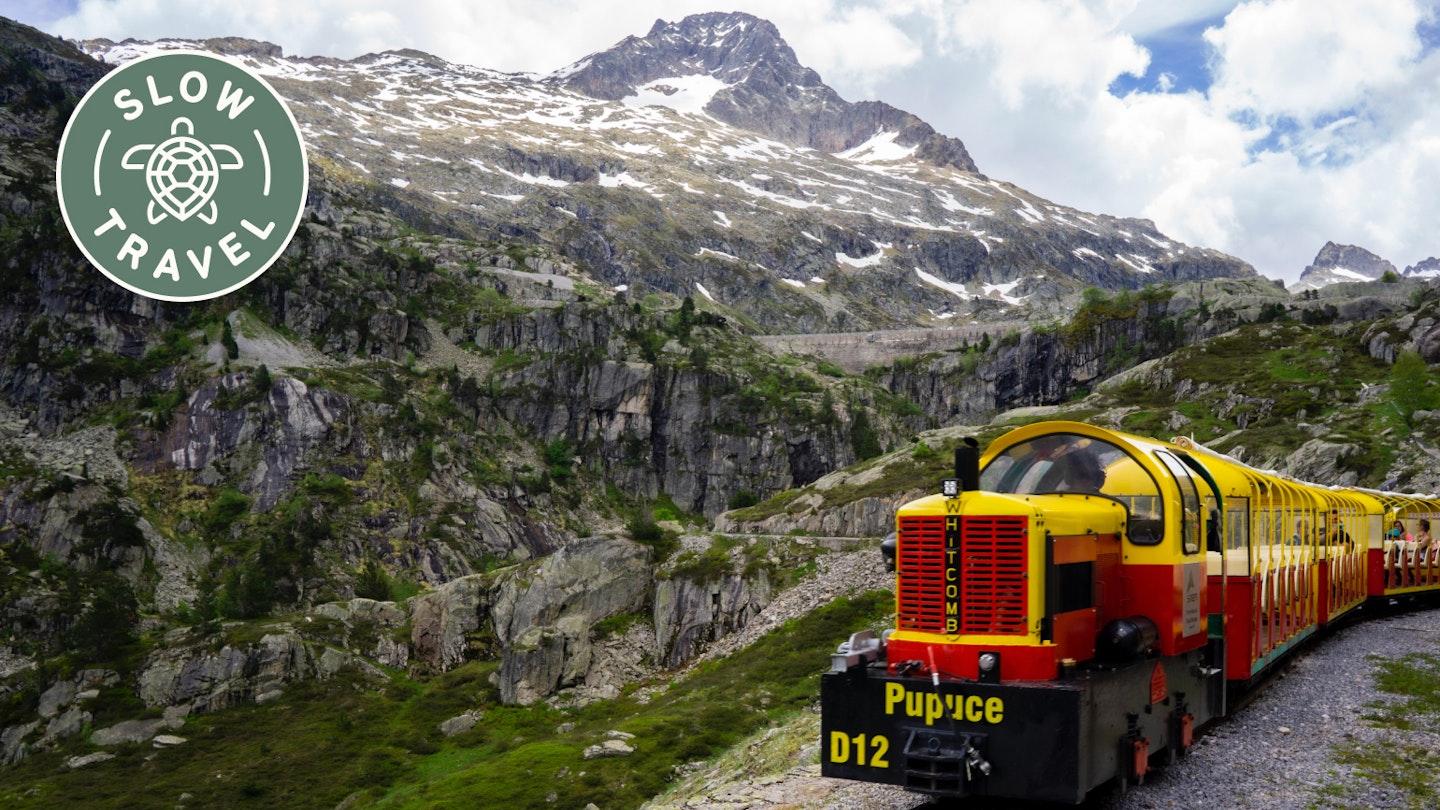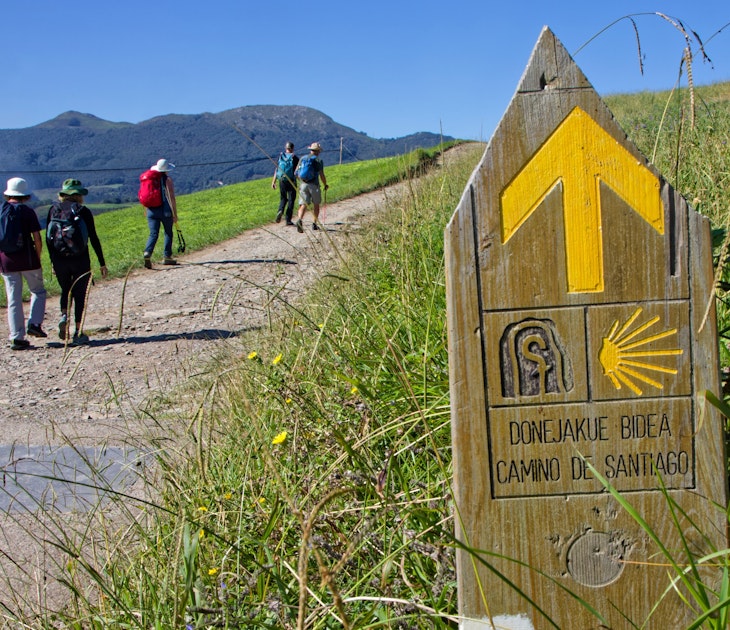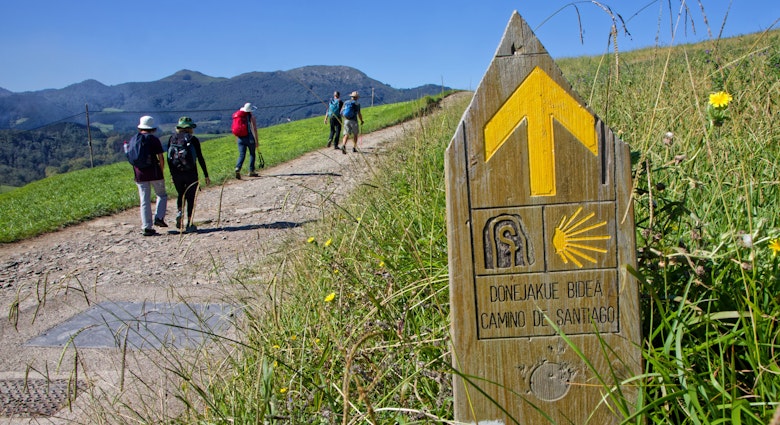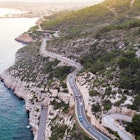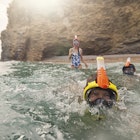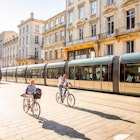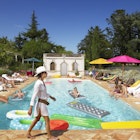Our slow travel series explores how you can take more mindful journeys by train, boat, bus or bike – with tips on how to reach your no-fly destination, and what to see and do along the way. Here, Christopher GJ Cooley explains how going hiking in the Pyrenees is possible by arriving on bicycle and high-altitude train.
From my home in Bordeaux, the towering peaks, glacial lakes and craggy glacial cirques of the nearby Pyrenees have tempted me for some time. The solitude visitors find in this mountain region – close enough as the crow flies – is testament to how hard it is to reach.
But it’s not impossible. So I set out to visit these beautiful peaks for a weekend, through a combination of cycling and hiking — with the assistance of a few strategically located trains. This was my first solo “bike ’n’ hike.” Here’s how I did it.
Taking the train to Pau
I roll my bike onto a quiet carriage, a hiking backpack protruding absurdly from one of its pannier bags. Destination? Pau, known as the “Gateway to the Pyrenees” thanks to its multiple rail connections. I attach my bike with the elastic strap and nab a window seat. We depart slowly through Bordeaux’s rusty rail yard, passing ancient freighters. I sit back with a good book and settle in for the two-hour journey south. Outside the window, countless dark pines formed the vast, flat forests of the Landes.
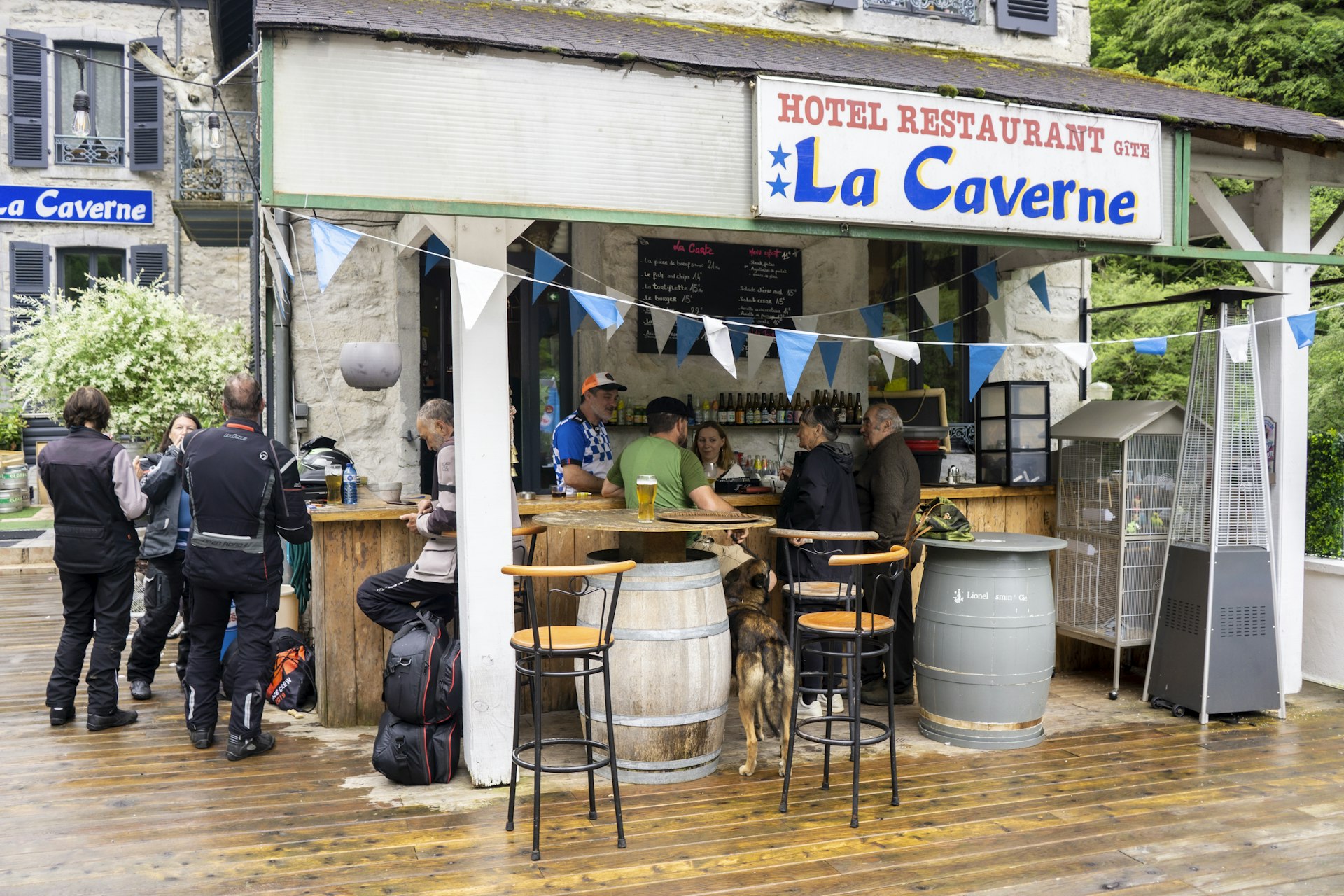
Cycling on to Artouste Fabrèges
After disembarking from the train, I get on the bike path leading south from Pau and pass a hedge trimmer, getting hit with the intense smell of freshly cut grass and wild mint: a small but memorable experience you’d never get in a car. I soon reach the unmissable winery Cave de Jurançon at Gan – and the chance to sample the local sweet white wine. As the sun emerges, I head off on the small roads that wind up toward the hills where the Jurançon grapes grow. After 12 miles (20km) I take the dedicated path leading to the Ossau Valley. (Anyone looking to minimize their saddle time can join the route at Buzy-en-Béarn station, reached by a different train from Pau.)
As the path turns to gravel, a shroud descends on the valley ahead, then the rain falls. Reaching Laruns, I take shelter in an old public washhouse, waiting for the worst to pass. When it has, I thread under overhanging cliffs into a gorge to start the climb up to my first stopover: an old-school thermal resort called Eaux-Chaudes.
This curious village is perched on the side of a ravine, the waters of the Gave d’Ossau tumbling loudly below. Besides the Wes Anderson–esque spa complex, there isn’t much else here – just a few seemingly deserted houses. Thankfully, I come across La Caverne, a standalone establishment full of activity – and my ideal base camp. As dusk falls, this hostel-bar-restaurant is brimming with a fantastic assortment of characters: scruffy Spanish climbers carrying boxes full of nylon ropes and carabiners, touring German motorcyclists, a handball club in for some pre-match team building, a lone mountaineering guide eating dinner in flip-flops and a handful of retirees demanding off-menu bananas flambé.
I’m awakened by a troupe of cows passing, their bells clanging out tuneless early-morning alpine jazz. Cycling again, I begin the ascent as the cool air keeps me fresh. The sun slowly emerges, illuminating the first forested peaks as the canyon road follows the river upstream. This is the start of the Col du Pourtalet (familiar to followers of the Tour de France). It’s one of the prettiest road ascents I’ve ever ridden, flanked by waterfalls, meadows of purple and yellow wildflowers and hamlets with fromageries selling sheep’s cheese.
As the road twists, I occasionally see white-capped peaks between the trees. (It’s nearly midsummer, so I know they must be very high indeed to still have snow.) I eventually leave the Col du Pourtalet route and skirt around the Lac de Fabrèges: nine miles (15km) up a gentle gradient with 1935ft (590m) of total elevation gain. It’s taken just over two hours, including lots of stops to take photos. Arriving at the lakeside ski station, I set about switching out my gear from pannier bags to hiking rucksack, then locking my bike to the railing opposite the ticket booth.
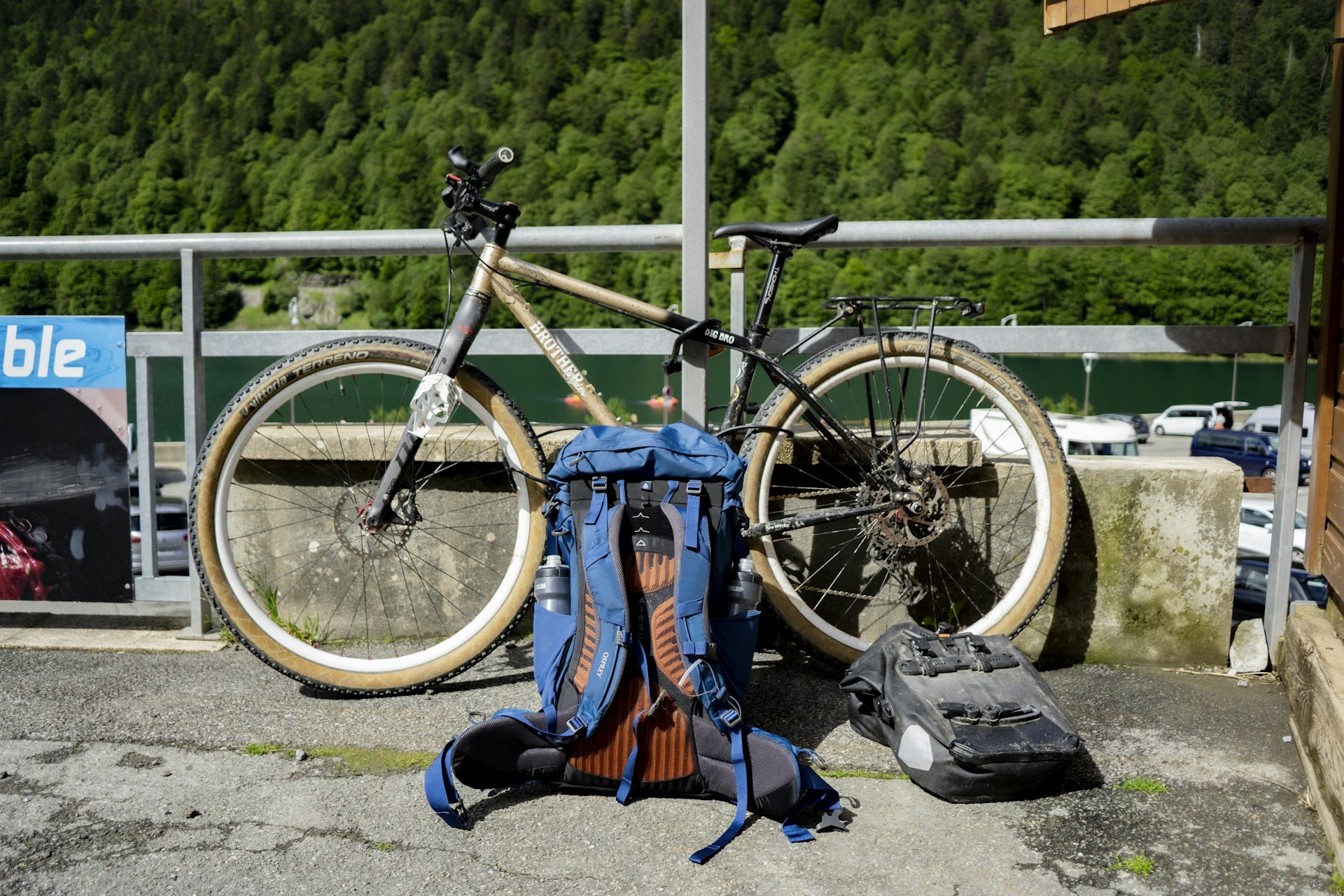
Getting even higher on a mountain railway, then a hike
The station is pleasantly quiet, but with enough people milling around that it doesn’t seem deserted. First, a ski lift delivers me to the train “platform” – and the immense Pic du Midi comes into view, jutting up into the clouds. After a short wait, I board the Train d’Artouste: the highest train on narrow gauge tracks in Europe.
After passing through a tunnel, the view changes completely; melting snow etches white lines down the mountainsides into the Soussouéou valley. The noisy little engine picks up surprising speed. A pair of marmots springs up the hillside beside the tracks. The scenery constantly evolves, becoming increasingly impressive as we twist and turn deeper into the heart of the mountain range. With startling sheer drops just inches from the narrow tracks, I understand why seatbelts must be worn at all times.
We stop, and two railway staff make some adjustments (or repairs!) to the rails – then we’re off again, with a clichéd choo-choo around another vertigo-inducing bend. The journey takes about an hour, yet with so much passing by, it seems shorter. The six-mile (10km) train line was originally built to transport workers and equipment to the construction site of the Artouste dam; here, everybody alights.
At the terminus, trails of varying difficulties are marked on a map, with something for everybody. I’ve stubbornly decided upon a challenging unsigned route that leads up to the lakes of Batboucou. I cross the dam, and a barely perceptible trail branches steeply uphill soon after. As I surmount the first crest, I see purple thistles and white flowers among the wiry grasses and smell thyme in the air.
I pick my way around the smaller of the lakes, then gingerly balance on stepping stones to cross a fast-flowing stream. Finally, I mount a rocky hillock and enter the hollow amphitheater of rugged rock faces and loose scree where solitude abides, the only flat surface the glassy water of the larger lake. The sun catches patches of pure white snow, then disappears as the phantom tendrils of storm clouds creep over the ridge above. As the downpour begins, I loop back around the other side of the big lake, exhilarated. Hopping between boulders, I’m a kid again, rock-pooling without parental supervision. I make it back down to the tracks before the last departure as visibility drops down to just a few meters.
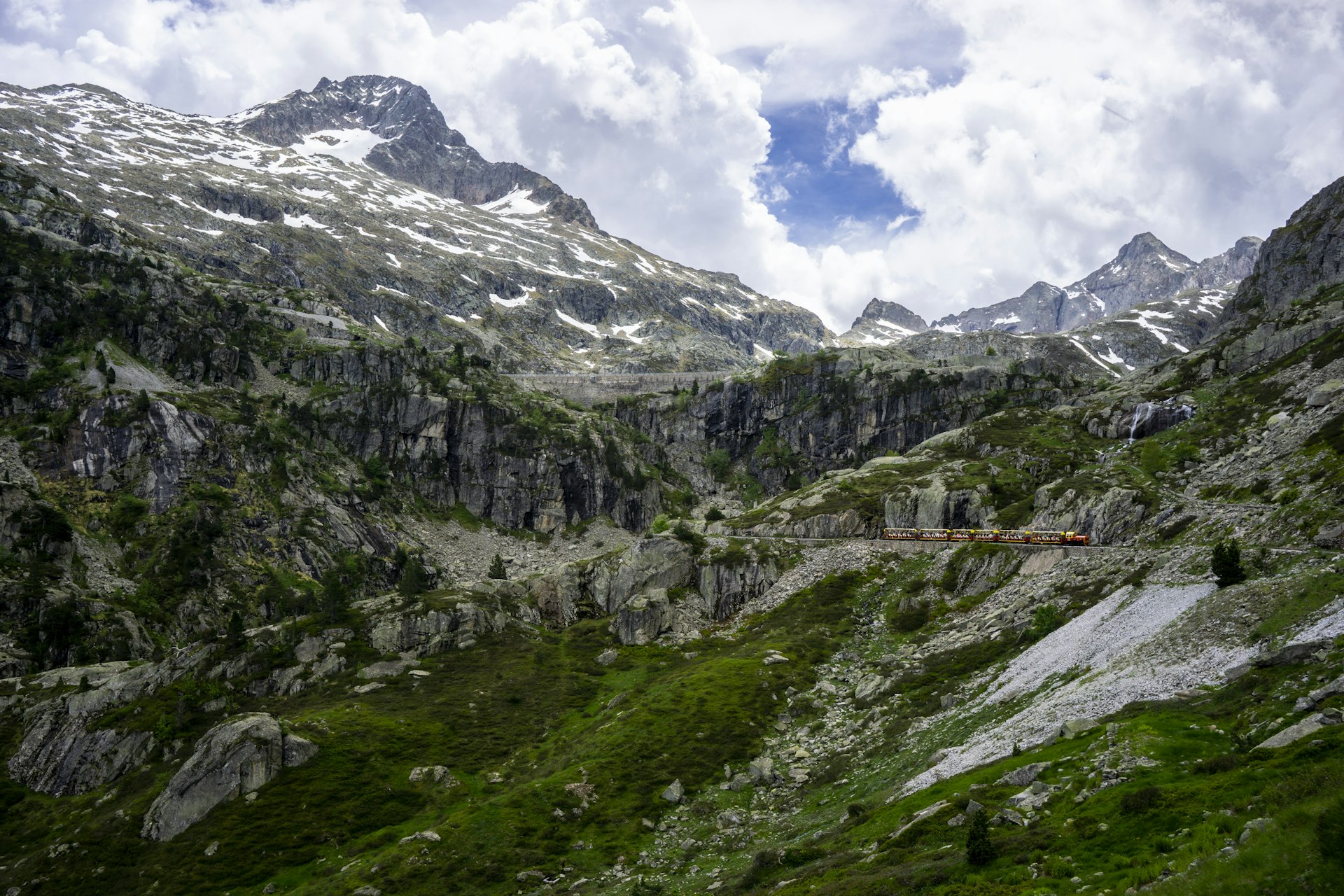
Waterproof tarpaulins have been unfurled over the open train carriages, blocking the view of the insides of clouds and letting drips drop on our heads. Still, by now I am content to be huddled up in our little train. I hurriedly repack my panniers during the ski-lift descent, watched closely by my bewildered fellow passengers.
The hot road steams in the rain as I freewheel back downhill. I feel the air temperature change suddenly on my skin as cold drafts rush from heaving waterfalls. I arrive drenched and mud splattered at Louvie-Juzon – where thankfully a gîte d’étape with a hot shower is waiting for me. I share a hearty home-cooked meal with a raucous group of Basque road cyclists, and a lone Italian pilgrim wending his way toward Santiago de Compostela.
After a short, dry road cycle back to Pau the following morning, I wait for the train back home, with aching leg muscles – and the feeling of a weekend well spent.

How to make it happen
Taking your bicycle on the train
It’s free to take bicycles aboard regional TER trains – but you can’t reserve, and when the train is full, it’s full, which means arriving early is key. Reserving the Train d’Artouste in advance is recommended, especially during high season.
Food and drink
There are many lakeside restaurants at Artouste Fabrèges and one atop of the ski lift, justifiably called Le Panoramic. There is also a small restaurant bar at the foot of the Artouste dam alighting point, so you don’t need to bring a picnic.
Facilities along the way
Count on using lockers along the way. I stashed all my bike-specific equipment in one to save weight on the hike. For €2, you’ll get a key at the ticket office at the bottom of the ski lift. The lockers are at the top, in a room marked “Salle hors sac.”
If I could do anything differently next time…I would try to avoid the storms! Yet no matter what the forecast says, the weather can change quickly in the mountains. So you should come prepared for anything.

